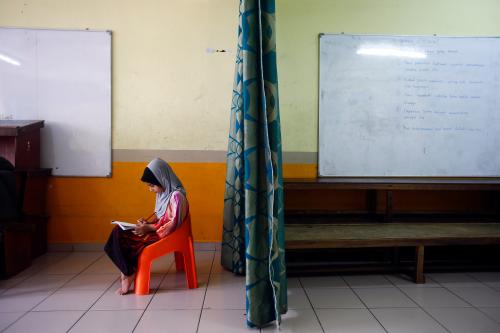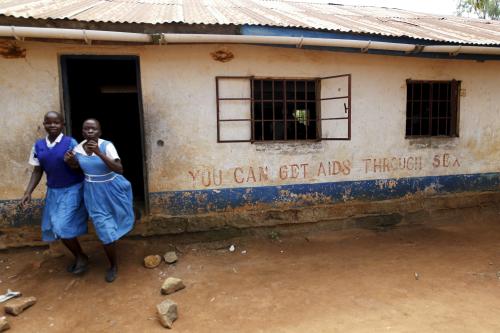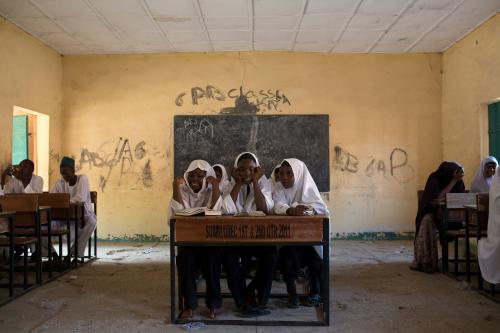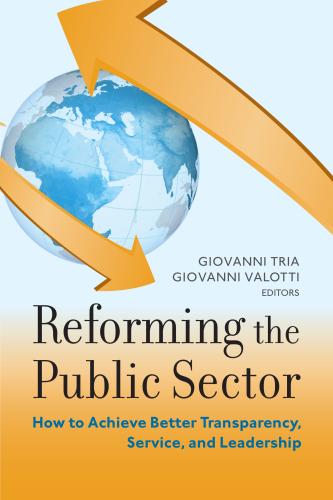Recently, we have been talking a lot about girls’ education issues—in particular, how to lift up the global ambition for girls. We have argued that it is time for the global community to move our collective focus up from enrolling girls and boys in school in equal numbers to ensuring that girls complete secondary education with the skills they need for their lives. To do this, we must focus in on “next generation” girls education issues, specifically ensuring the missing millions of girls are in education, making schools safe and girl friendly, improving learning quality, and supporting transitions to livelihoods and leadership. While these second generation issues have long been discussed in academic corridors and NGO programs, there remains opportunity to move them into spotlight among policymakers and world leaders.
On Wednesday, when First Lady Michelle Obama challenged a group of young African leaders ahead of next week’s U.S.-Africa Leaders Summit to focus on girls’ education, she joined a number of high-profile women leaders who have recently been speaking out forcefully on girls’ education. This includes Prime Minister Erna Solberg of Norway, former U.S. Secretary of State Hillary Clinton, former Prime Minister of Australia Julia Gillard, and U.K. Secretary of State Justine Greening. These leaders’ calls to action add to those by many advocates and donors to the cause of girl’s education, like Malala Yousafzai, who knows all too personally what threats to girls’ education look like. The U.K. government is the leader among large aid donors in supporting girls’ education, as one of the largest supporters of the Global Partnership for Education (GPE), which includes a strong focus on equity, and with their more than 350 million British pound Girls Education Challenge that aims to improve the lives of a million marginalized girls through education. And Norway is positioning itself as a global leader in education, having doubled its support to GPE this year, and putting a strong focus on girls’ education in its new global education white paper.
Support such as this from large aid donors, and crucially from developing country governments in girls’ education hotspots, is essential for helping build strong systems that advance the needs of girls and boys equally. But this systems-level work often has difficulty supporting a key ally in tackling the next generation issues, namely developing-country girls’ education leaders. There are thousands of social entrepreneurs across sub-Saharan Africa, the Middle East, and South West Asia—three regions in the world where girls struggle the most to get educated—that are creatively tackling these next generation issues in their particular context. Their work provides a powerful complement to systemic action in girls’ education and should be supported and amplified.
Ashoka, a worldwide network of social entrepreneurs, defines a social entrepreneur as an individual with “innovative solutions to society’s most pressing social problems” and describes them as ambitious and persistent in pursuing their goals. If we are going to succeed in lifting up the global ambition for girls’ education, we will need a strong cadre of social entrepreneurs in developing countries tackling the issue. This is true for several reasons. First, girls’ education leaders or social entrepreneurs will continue to focus on helping girls get a quality education, no matter if government priorities change with new administrations, as they often do. Second, as important members of civil society, which they frequently are, these developing country leaders can help keep their governments accountable to girls. Third, the solution set for how to address the next generation issues remains profoundly local and social entrepreneurs are needed to find the right ways to, for example, bring girls to school in rural Northern Nigeria versus in the urban slums of India.
In our own experience, working closely with developing-country social entrepreneurs on girls’ education through our Echidna Scholars program, we are increasingly convinced of the need for improved mechanisms for providing leaders such as these with ongoing support. A number of our colleagues who have spent time with us as Echidna Scholars are highly successful in their work, developing ideas, testing them out, growing networks of support, partnering with actors, including the government, to scale up interventions. But all of them talk about their significant need for sustained support, both in terms of professional networks that can help make their road “less lonely” as well as financing for their work. Civil society support in low and even middle-income countries is widely acknowledged to be difficult. For example, a European Union report found that for most NGOs in its middle-income countries there is a “vicious cycle” of underfunding and insufficient capacity. And a global survey of civil society organizations found that engagement with large intergovernmental organizations is “monopolised by well-resourced and well versed CSOs [civil society organizations], whilst under-representing grassroots activists.” That means many of the most innovative and important leaders in girls’ education are missing out on the resources they need.
One concrete way to support these developing-country girls’ education leaders would be to create a mechanism that provides long-lasting support, multiplying their impact over time. A Girls’ Education Leadership Fund could be set up, providing ongoing support to social entrepreneurs working on girls’ education. A fund or mechanism such as this need not be overly complicated or heavy. It could narrow its focus by supporting developing country leaders who are working on one or more of the second generation girls’ education issues and it could partner with existing initiatives to invite applications and establish a governance board. Such an initiative is likely to be particularly attractive to philanthropists and private foundations, given the very tangible nature of supporting individuals to amplify their work.
One of the most difficult problems in connecting donor dollars to social entrepreneurs is the selection process. Funders often worry about how to identify which entrepreneurs to support, and many worry about making a mistake and supporting actors who are not who they say they are. However, there are multiple initiatives from all over the globe that already do a rigorous job of identifying social entrepreneurs and leaders in the developing world who are doing important work and would merit ongoing support. There are initiatives focused on girls’ education, including our Echidna Scholars, as well as the Cama Network made up of more than 24,000 alumnae from Camfed’s educational programs. There are initiatives that focus on women or girls broadly, of whom a subsection of participants focus on girls’ education, such as: Vital Voices, who have trained and mentored more than 14,000 women; Akili Dada, the Kenyan “leadership Incubator” for young women; and the Latin-American International Indigenous Women’s Forum. There are also networks of social entrepreneurs focusing on a wide range issues—like Ashoka’s—including: the Mastercard Scholars which is made up of thousands of talented young people in Africa; the HUB Impact Johannesburg which provides entrepreneurs accelerator programs and consultant support; and the State Department’s YALI Mandela Washington Fellows. Entrepreneurs coming from these programs and working on girls’ education would also be very viable candidates for funding from a fund for girls’ education leaders.
We know that the next generation of girls’ education issues are wide-reaching, and we know we need solutions that are locally relevant and lasting. Investing in the next generation of leaders could do just that.








Commentary
Empowering (and Funding) a New Generation of Leaders to Tackle the Next Set of Challenges in Girls’ Education
August 1, 2014